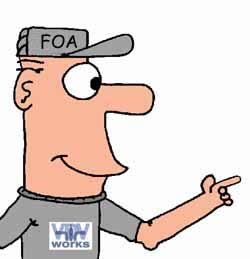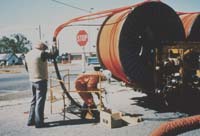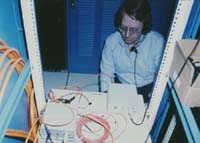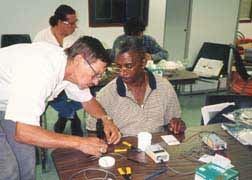
- Lennie Lightwave's
- Guide To Fiber Optics
Basics
Getting Started in Fiber Optics - You need tools, test equipment and - most of all - training!
This guide will help you get started by providing very basic information (we will also point you to more advanced studies) and demonstrating that you don't need to break the bank to break into the field.
- What is "Fiber Optics"? And a short history.
- It's the communications technology that works by sending signals down hair thin strands of glass fiber (and sometimes plastic fiber.) It began about 30 years ago in the R&D labs (Corning, Bell Labs, ITT UK, etc.) and was first installed in Chicago in 1976. By the early 1980s, fiber networks connected the major cities on each coast.
- By the mid-80s, fiber was replacing all the telco copper, microwave and satellite links. In the 90s, CATV discovered fiber and used it first to enhance the reliability of their networks, a big problem. Along the way, the discovered they could offer phone and Internet service on that same fiber and greatly enlarged their markets. Now, even fiber to the home (FTTH) is cost effective.
- Computers and LANs started using fiber about the same time as the telcos. Industrial links were among the first as the noise immunity of fiber and its distance capability make it ideal for the factory floor. Mainframe storage networks came next, the predecessors of today's fiber SANs (storage area networks.)
- Other applications developed too: aircraft, ship and automobile data busses, CCTV for security, even links for consumer digital stereo!
- Today fiber optics is either the dominant medium or a logical choice for every communication system.
Which Fiber Optics?
Whenever you read an article or talk to someone about fiber optics, you need to know the point of view of the writer. Fiber optics, you see, is not all the same. Is the writer discussing "outside plant" fiber optics as used in telephone networks or CATV. Or is the article about "premises" fiber optics as found in buildings and campuses?
Just like "wire" which can mean lots of different things - power, security, HVAC, CCTV, LAN or telephone - fiber optics is not all the same. And this can be a big source of confusion to the novice. Lets define our terms.
Outside Plant (OSP)
Telephone companies, CATV and the Internet all use lots of fiber optics, most of which is outside buildings. It hangs from poles, is buried underground, pulled through conduit or is even submerged underwater. Most of it goes relatively long distances, from a few thousand feet to hundreds of miles.
Outside plant installations are all singlemode fiber (we'll define the fiber types in the next chapter), and cables often have very high fiber counts, up to 288 fibers. Cable designs are optimized for resisting moisture and rodent damage. Installation requires special pullers or plows, and even trailers to carry giant spools of cable.
Long distances mean cables are spliced together, since cables are not longer than about 4 km (2.5 miles), and most splices are by fusion splicing. Connectors (SC, ST or FC styles) on factory made pigtails are spliced onto the end of the cable. After installation, every fiber and every splice is tested with an OTDR.
If this sounds like big bucks, you are right! The installer usually has a temperature controlled van or trailer for splicing and/or a bucket truck. Investments in fusion splicers and OTDRs can add up to over $100,000 alone.
Contractors doing outside plant work are few and far between. Most outside plant telephone installs are done by the telco themselves, while a small number of large, specialized installers do CATV work.
Premises Cabling
By contrast, premises cabling- cabling installed in a building or campus - involves short lengths, rarely longer than a few hundred feet, with 2 to 48 fibers per cable typically. The fiber is mostly multimode, except for the enlightened user who installs hybrid cable with both multimode and singlemode fibers.
Splicing is practically unknown in premises applications. Cables between buildings can be bought with double jackets, PE for outside plant protection over PVC for building applications requiring flame retardant cable jackets, so cables can be run continuously between buildings. Today's connectors often have lower loss than splices, and patch panels give more flexibility for moves, adds and changes.
Most connectors are ST style with a few SCs here and there. Termination is by installing connectors directly on the ends of the fibers, primarily using adhesive technology or occasionally some other variety of termination method. Testing is done by a source and meter, but every installer should have a flashlight type tracer to check fiber continuity and connection.
Unlike the outside plant technician, the premises cabler (who is often also installing the power cable and Cat 5 for LANs too!) probably has an investment of less than $2,000 in tools and test equipment.
There are thousands of cabling installers who do fiber optic work. They've found out it isn't "rocket science," and their small initial investment in training, tools and test equipment is rapidly paid back.
The Installers
Few installers do both outside plant and premises cabling. The companies that do are usually very large and often have separate divisions doing each with different personnel. Most contractors do nothing but premises cabling.
Fiber vs Copper
If you are already terminating copper wire then you are well along in learning to install fiber.
Twenty five years ago, fiber was just being introduced and required PhD's from Bell Labs to install it while copper wire was easy to install. Today it is often the opposite. Because fiber is so powerful, at today's network speeds fiber is hardly working hard at all and can look to the future of ten gigabit speeds with confidence. Copper on the other hand, can handle gigabit Ethernet but only if it is carefully installed and tested with very expensive test equipment and components. Even the experts have to be very careful because it has little "headroom".
Also, if you are currently working with copper, you also have to know that LAN copper cable is delicate. It only has a 25 pound pulling tension limit and kinks will ruin the high speed performance. With fiber - even though it's glass fiber - it has more strength and greater tolerance to abuse than copper wire. (What do you think gives the strength to your "fiberglass" boat?)
OK, you might say, I can buy everything you've said so far, but isn't fiber more expensive?
Telcos and CATV operators use fiber because it's much cheaper. They optimize their network to take advantage of fiber's speed and distance advantages. In LANs, you need to follow the new EIA/TIA 568 B.3 standard to optimize the fiber usage, and then it can be cheaper than copper. How about test equipment? Guess again Fiber optic test equipment costs lots less than Cat 5e/6 testers. See Networks where we will show you how the setup for a fiber network has some surprising savings.
The Secret To Success In Fiber Optics Is Training!
You wouldn't try to drive a truck or fly a plane without taking lessons. Likewise for improving your golf or tennis game. Well, the secret to fiber optics is training too. With some basic knowledge and hands-on practice gained in a training course, fiber is pretty easy to install.
Where to get training?
Well, you can start right here, of course! But this guide is only designed to get you started and you should have "hands-on" training leading to a recognized certification program to be qualified to install fiber. The Fiber Optic Association is the industry professional society and has hundreds of approved schools aroudn the world that offer training and the FOA certification, recognized everywhere. FOA also has a free online training program at Fiber U. Finally, take advantage of the training offered by manufacturers and distributors whenever you can, often this training is free or cheap! (but limited to the equipment being "pushed" of course.)
See the section on training at the end for more information.
Standards
Most of what we call standards are voluntary standards, created by industry groups to insure product compatibility. They are not "codes" or actual laws that you must follow to be in compliance with local ordinances.
Standards like EIA/TIA 568 ( from the Electronic Industries Alliance/ Telecommunications Industry Association in the US. IEC and ISO create standards for the rest of the world.) which covers all of the things you need to know to install a standard premises cabling network are good guidelines for designs, but just guidelines - they are not mandatory. Standards for fiber optic components and testing have been set by several groups, but most in the US follow the EIA/TIA developed FOTP's (fiber optic test procedures) for testing. Some of the EIA procedures are also called OFSTP (optical fiber system test procedures) like OFSTP-14 for the installed cable plant.
Standards for optical power measurements are set by NIST (the US National Institute of Standards and Technology)
The only common mandatory standard (we call them "codes") is the NEC 770 (National Electrical Code). The NEC specifies fire prevention standards for fiber optic cables. If a cable doesn't have a NEC rating - don't install it - it won't pass inspection!
A complete listing of the EIA/TIA standards is on the website of The Fiber Optic Association. Information on the EIA/TIA standards can be found on the website of most of he suppliers of structured cabling hardware.
Before we get started - Safety First!
You might think that eye damage from working with lasers would be the big concern in fiber optic installations. The reality is that high power lasers burning holes in metal or burning off warts mostly have little relevance to your typical fiber optic installation. Optical sources used in fiber optics are of much lower power levels (The exception is high power DWDM or CATV systems). Of course, you should always be careful with your eyes, especially when using a fiber optic microscope. NEVER look into a fiber unless you know no light is present - use a power meter to check it - and anyway, the light is in the infrared and you can't see anything anyway!
 The real safety lecture will always be about small scraps of glass cleaved off the ends of the fibers being terminated or spliced. These scraps are very dangerous! The cleaved ends are extremely sharp and can easily penetrate your skin. If they get into your eyes, they are very hard to flush out. Don't even think about what happens if you eat one. Safety glasses are a must!
The real safety lecture will always be about small scraps of glass cleaved off the ends of the fibers being terminated or spliced. These scraps are very dangerous! The cleaved ends are extremely sharp and can easily penetrate your skin. If they get into your eyes, they are very hard to flush out. Don't even think about what happens if you eat one. Safety glasses are a must!
Always follow these rules when working with fiber.
1. Dispose of all scraps properly.
2. Always use a properly marked container to dispose of later and work on a black pad which makes the slivers of glass easier to spot.
3. Do not drop them on the floor where they will stick in carpets or shoes and be carried elsewhere.
4. Do not eat or drink anywhere near the work area.
Fiber optic splicing and termination use various chemical adhesives and cleaners as part of the processes. Follow the instructions for use carefully. Remember, even simple isopropyl alcohol, used as a cleaner, is flammable.
Zero Tolerance for Dirt
With fiber optics, our tolerance to dirt is near zero. Airborne particles are about the size of the core of SM fiber- they absorb lots of light and may scratch connectors if not removed! Dirt on connectors is the biggest cause of scratches on polished connectors and high loss measurements!
1. Try to work in a clean area. Avoid working around heating outlets, as they blow dust all over you
2. Always keep dust caps on connectors, bulkhead splices, patch panels or anything else that is going to have a connection made with it.
3. Use lint free pads and isopropyl alcohol to clean the connectors.
4. Ferrules on the connectors/cables used for testing will get dirty by scraping off the material of the alignment sleeve in the splice bushing - creating a 1-2 dB attenuator. You can see the front edge of the connector ferrule getting black! Use the metal or ceramic alignment sleeve bulkheads only for testing.
